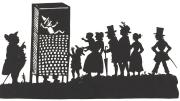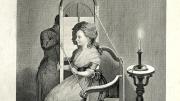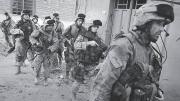The artifact called a silhouette is named after Etienne de Silhouette, a penny-pinching minister of finances under Louis XV, whose tenure was brief because parsimony rarely has a big following, especially among the wealthy. The phrase à la Silhouette came to mean doing things on the cheap. At the same time, in the second half of the eighteenth century, an old but until then little-practiced form of portraiture was burgeoning in popularity. An artist with scissors and maybe a knife could cut a pleasing and remarkably expressive outline of the shadow of a face for a quick likeness. No oil paint or years in the Academy required. Popularizers of the technique claimed that amateurs could make portraits of loved ones as well as artists could. Cheap to make, they were dubbed silhouettes, and the name stuck.
Caroline Duroselle-Melish, assistant curator in the Department of Printing and Graphic Arts at Harvard’s Houghton Library, put together a small exhibition of such works last summer, Silhouettes: From Craft to Art, that suggested the dimensions of the field. She wrote that silhouettes “largely owe their fame to a four-volume treatise on physiognomy written by the German Swiss evangelical pastor Johann Caspar Lavater (1741-1801) and to an increasing demand for portraiture.” Lavater developed a pseudo-scientific method to analyze human character through portrait silhouettes. His book, she noted, “translated into many languages and published in numerous editions, was greeted with both praise and criticism, but his instructions on how to draw silhouettes and the numerous engraved ones published in his book caught the public’s interest and contributed to the rage for their production.”
Various devices appeared meant to facilitate the cutting of accurate silhouettes, including the one shown in the 1792 engraving at top by Thomas Holloway titled “A sure and convenient Machine for drawing Silhouettes.” Because of the difficulty of working by the light of a flickering candle, and the fidgeting of one’s subject, artists may have found they could do better work freehand.
The portrait of scholar J. A. Dathe is from a collection published in 1779 by print dealer Johann Carl Müller. The silhouettes were printed separately from their etched ornamental frames.
The villagers at bottom are from an album presented as a Christmas gift in 1858 that also includes hunting and nature scenes, many inspired by the silhouettes of the German children’s-book illustrator Karl Frölich.
“Today,” wrote Duroselle-Melish in closing, “silhouettes have regained vitality as a craft form. They are present in multiple public spaces, from streets to museums, and can be found in books and on screen. Continually evolving, they are here to last.”










